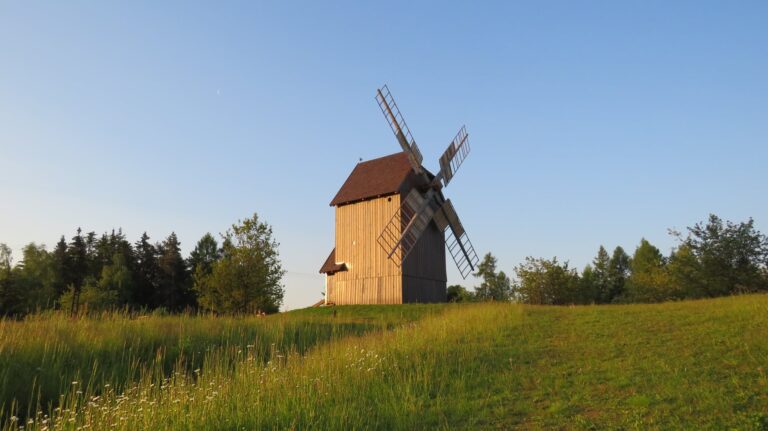Region of Hradec Králové
North-eastern region and ski paradise
PERSONAGES
Karel Čapek
(1890 - 1938) World-famous writer, playwright, and columnist. Born in Malé Svatoňovice, a village north of the capital Hradec Králové. Čapek's work is very wide and varied, one must surely remember the famous three-act play R.U.R. (Rossumovi universální roboti) where the word robot (from the Czech robota, "hard work, forced labor") appears for the first time and is subsequently used worldwide. The term was invented and suggested by Josef, brother of Karel Čapek, a well-known painter and illustrator as well as the author of various works in collaboration with his brother.
Antonìn Petrof
(1839 - 1915) One of the most important manufacturers of pianos and musical instruments who 155 years ago founded a company that is now known throughout the world. The PETROF company exports pianos to 65 countries.
Bez práce nejsou koláče
Without work, there are no koláče (Czech pastry).
WHAT TO EAT
Krkonošské kyselo
Soup typical of the Giant Mountains and Podkrkonoší region. The soup is made of sourdough bread, flavored with mushrooms from local forests and potatoes, which are added at the end.
Miletínské modlitbičky
(Milotín's Prayers)
A cake from Miletín, where the Czech writer, poet and folklorist Karel Jaromír Erben was born. This cake was invented by a distant relative of his. A prayer-book-shaped cake with a honeyed gingerbread base, filled with hazelnuts, enclosed in a sugar shell and decorated on top with a cross-shaped almond.
A cake from Miletín, where the Czech writer, poet and folklorist Karel Jaromír Erben was born. This cake was invented by a distant relative of his. A prayer-book-shaped cake with a honeyed gingerbread base, filled with hazelnuts, enclosed in a sugar shell and decorated on top with a cross-shaped almond.
Hořické Trubičky
The most famous traditional specialty of the Podkrkonoší region. According to legend, the recipe was brought here by Napoleonic soldiers in 1812. They are hand-baked shortbread wafers, sprinkled with sugar and enriched with various fillings.
MUST-SEE
Klášter Broumov
(Broumov Monastery)
In 1213 King Přemysl Otakar I donated the Broumov territory to the Benedictine Order. The original fortress, which was later burnt down, was replaced by the monastery with a Gothic church dedicated to St. Adalbert (Svatý Vojtěch). In the Broumov complex, there is a unique copy of the Holy Shroud of Turin, which was given in 1651 by the archbishop of Turin to the archbishop of Prague, who donated it to the Broumov monastery. There are about forty historical copies of the Shroud of Turin in the world but the Broumov copy is the only one in Central Europe and is also one of the most successful.
In 1213 King Přemysl Otakar I donated the Broumov territory to the Benedictine Order. The original fortress, which was later burnt down, was replaced by the monastery with a Gothic church dedicated to St. Adalbert (Svatý Vojtěch). In the Broumov complex, there is a unique copy of the Holy Shroud of Turin, which was given in 1651 by the archbishop of Turin to the archbishop of Prague, who donated it to the Broumov monastery. There are about forty historical copies of the Shroud of Turin in the world but the Broumov copy is the only one in Central Europe and is also one of the most successful.
Hospitál Kuks
Kuks Hospital was founded by Count František Antonín Špork at the beginning of the 18th century as a resting place for elderly retired soldiers being cared for by the Order of the Brothers of Mercy. It is an important Baroque monument built to the designs of world-famous artists, especially the architect Giovanni Batista Alliprandi and the sculptor Matthias Bernard Braun. The Kuks Hospital grounds are famous for the monumental Holy Trinity Church, allegorical sculptures of the Virtues and Vices, and one of the oldest Baroque pharmacies - the Pomegranate.
Větrný mlýn Borovnice
Windmills were an inseparable part of our region. There were five windmills in the village of Borovnice and several windmills were built in the surrounding villages as well. The last mill in Borovnice stood for 120 years. In 1968 it was dismantled and stored, and it is currently kept in the open-air museum in Kouřim. The replica of Borovnice was completed by volunteers in 2020.
PICTURES

Baroque Kuks Hospital
Picture by Ladislav Renner
Hradec Králové, Czech Republic

Wooden Windmill in Borovnice
Photo Archive
Hradec Králové, Czech Republic

Benedictine monastery in Broumov
Picture by Ondřej Littera
Hradec Králové, Czech Republic
